This is the multi-page printable view of this section. Click here to print.
Virtualized Platforms
1 - Hyper-V
Talos is known to work on Hyper-V; however, it is currently undocumented.
2 - KVM
Talos is known to work on KVM; however, it is currently undocumented.
3 - Proxmox
In this guide we will create a Kubernetes cluster using Proxmox.
Video Walkthrough
To see a live demo of this writeup, visit Youtube here:
Installation
How to Get Proxmox
It is assumed that you have already installed Proxmox onto the server you wish to create Talos VMs on. Visit the Proxmox downloads page if necessary.
Install talosctl
You can download talosctl via
github.com/talos-systems/talos/releases
curl https://github.com/siderolabs/talos/releases/download/<version>/talosctl-<platform>-<arch> -L -o talosctl
For example version v0.8.0 for linux platform:
curl https://github.com/siderolabs/talos/releases/download/v0.8.0/talosctl-linux-amd64 -L -o talosctl
sudo cp talosctl /usr/local/bin
sudo chmod +x /usr/local/bin/talosctl
Download ISO Image
In order to install Talos in Proxmox, you will need the ISO image from the Talos release page.
You can download talos-amd64.iso via
github.com/talos-systems/talos/releases
mkdir -p _out/
curl https://github.com/siderolabs/talos/releases/download/<version>/talos-<arch>.iso -L -o _out/talos-<arch>.iso
For example version v0.8.0 for linux platform:
mkdir -p _out/
curl https://github.com/siderolabs/talos/releases/download/v0.8.0/talos-amd64.iso -L -o _out/talos-amd64.iso
Upload ISO
From the Proxmox UI, select the “local” storage and enter the “Content” section. Click the “Upload” button:
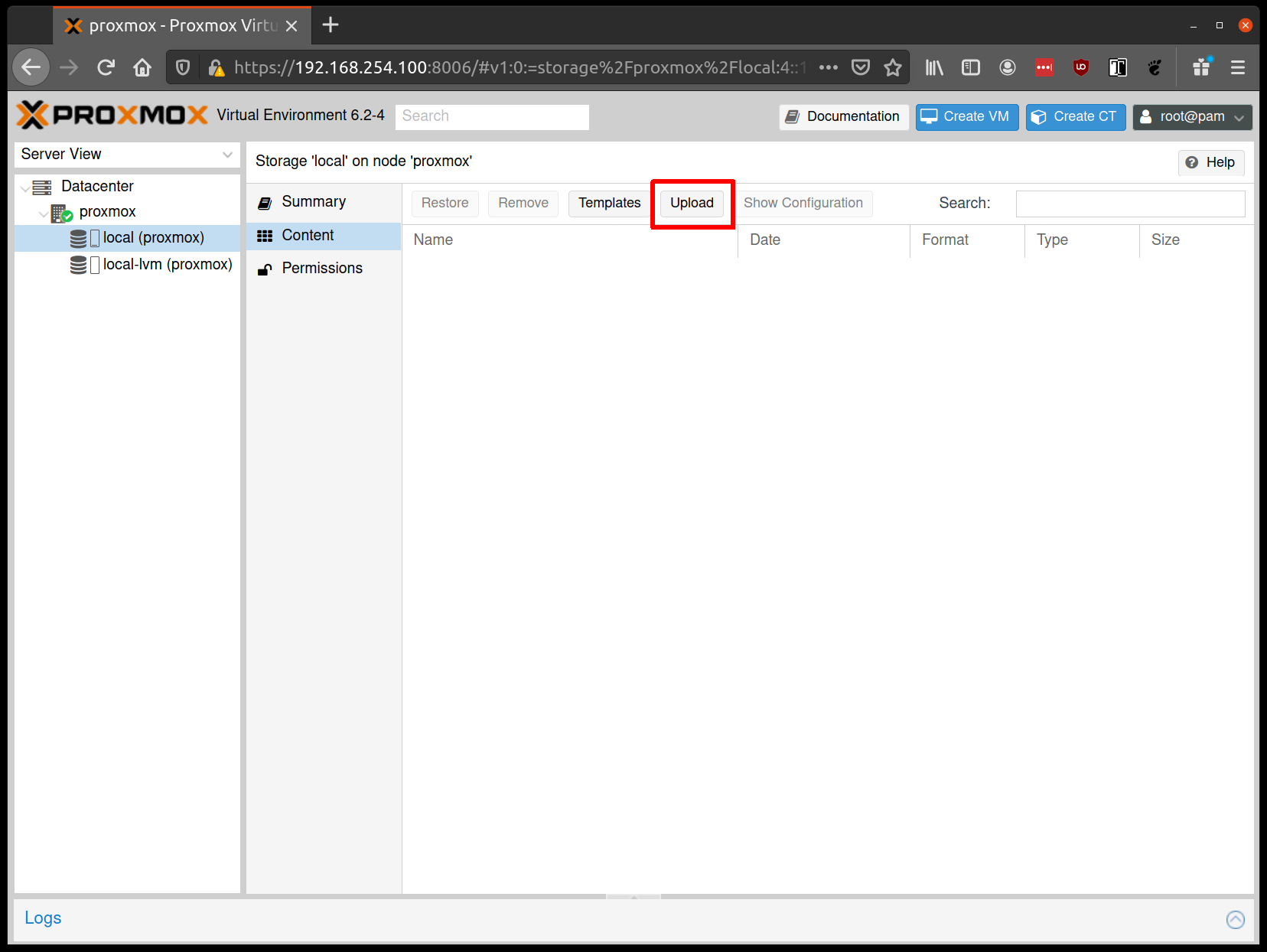
Select the ISO you downloaded previously, then hit “Upload”
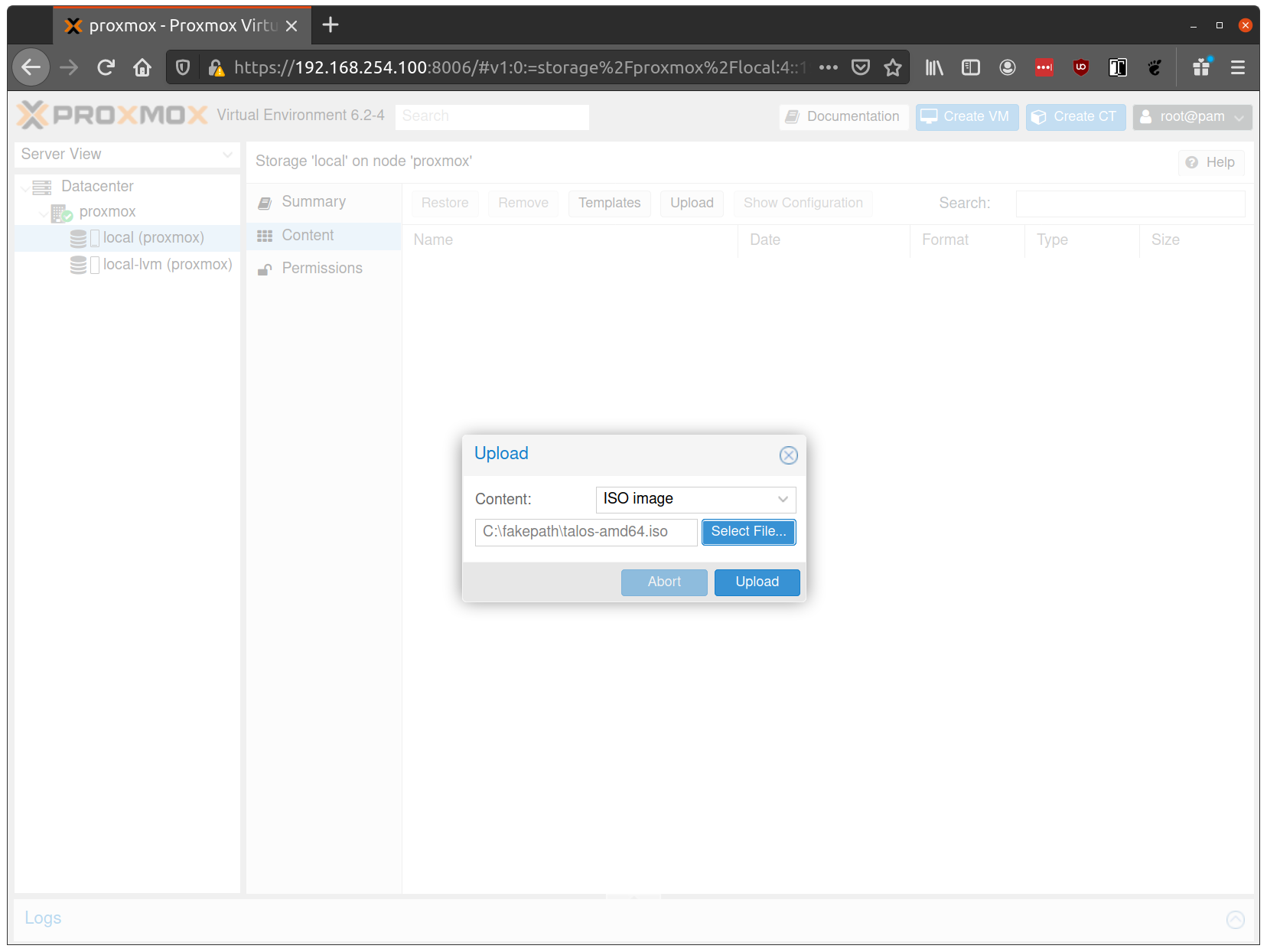
Create VMs
Start by creating a new VM by clicking the “Create VM” button in the Proxmox UI:
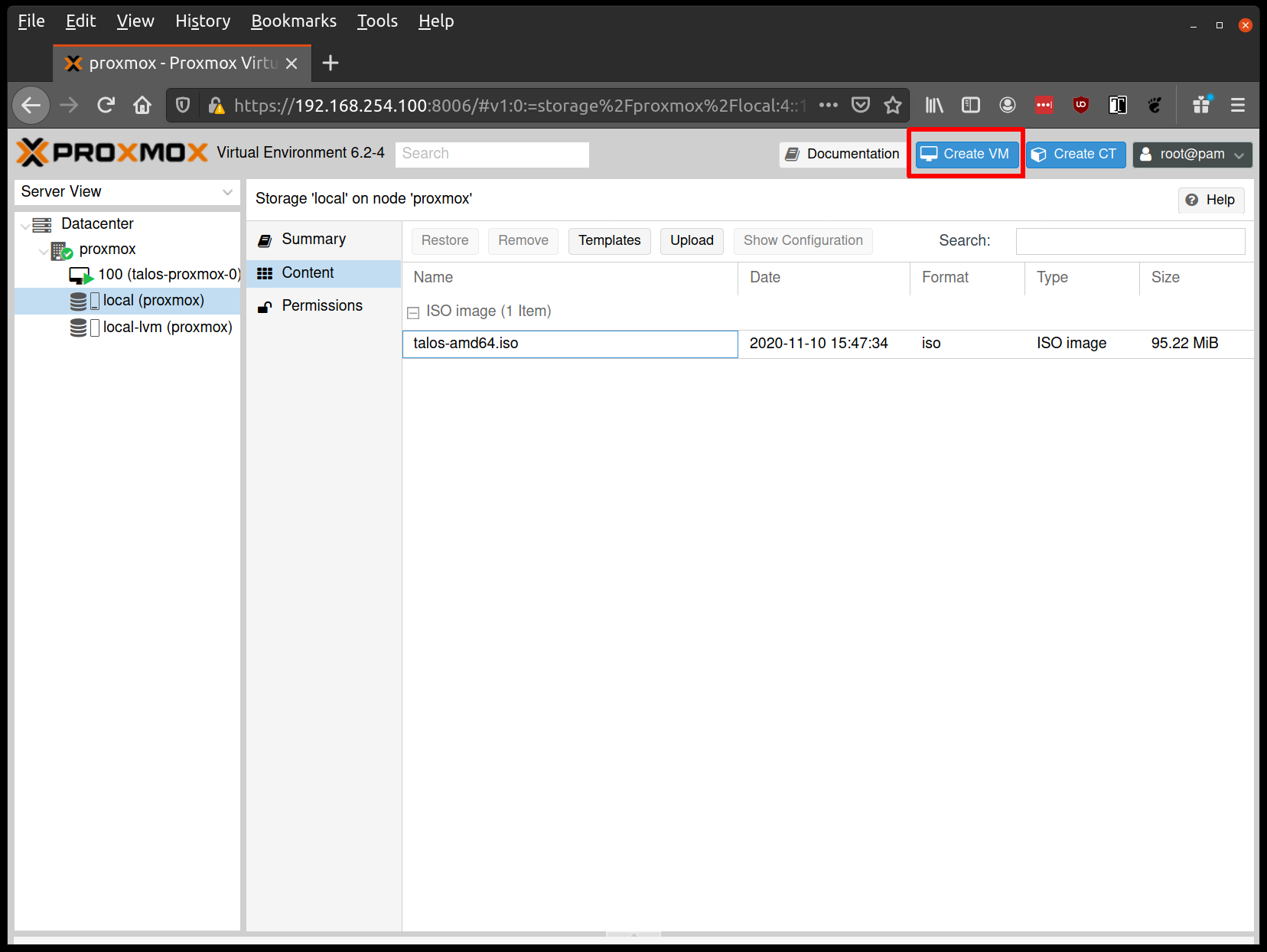
Fill out a name for the new VM:
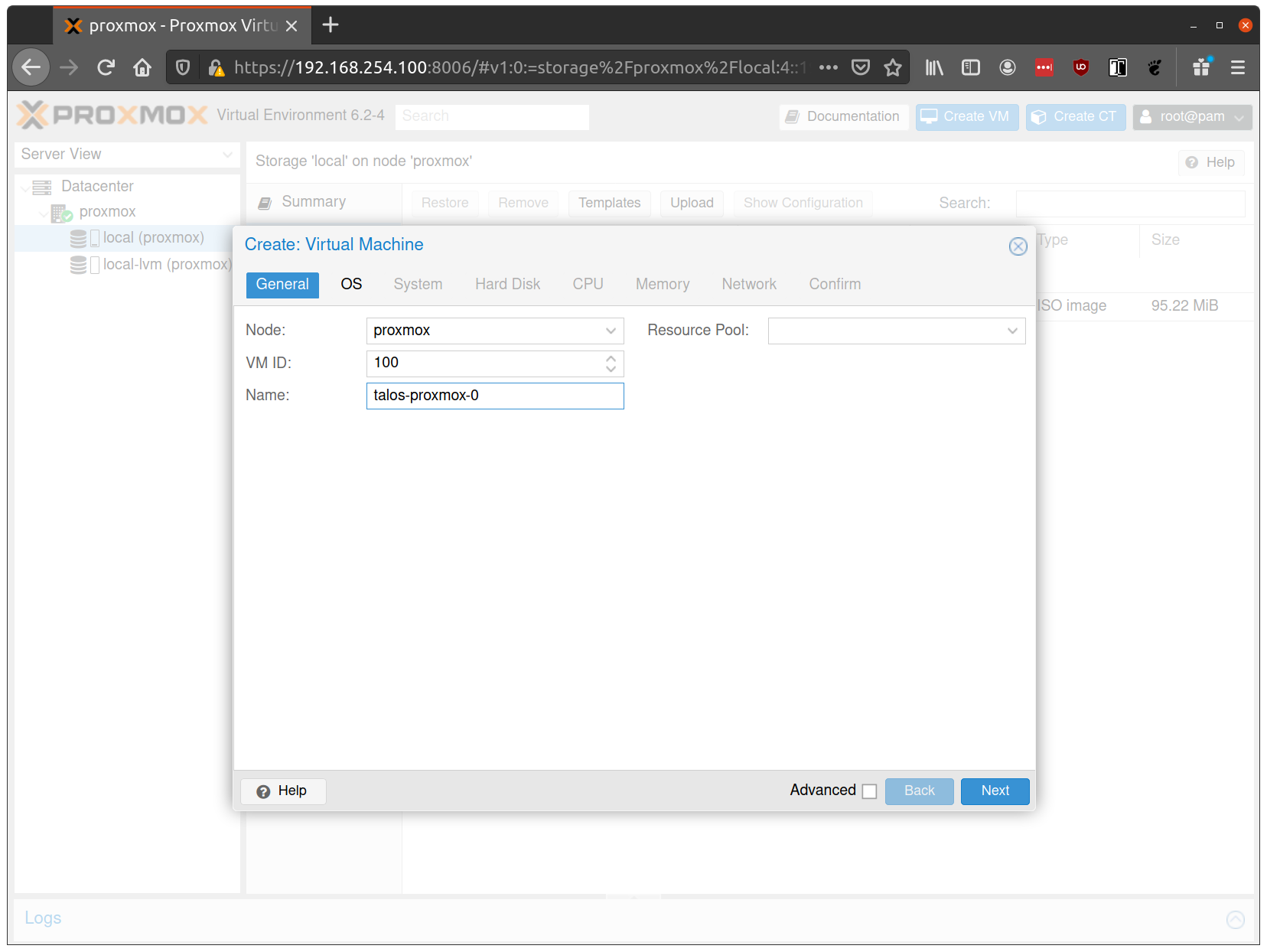
In the OS tab, select the ISO we uploaded earlier:
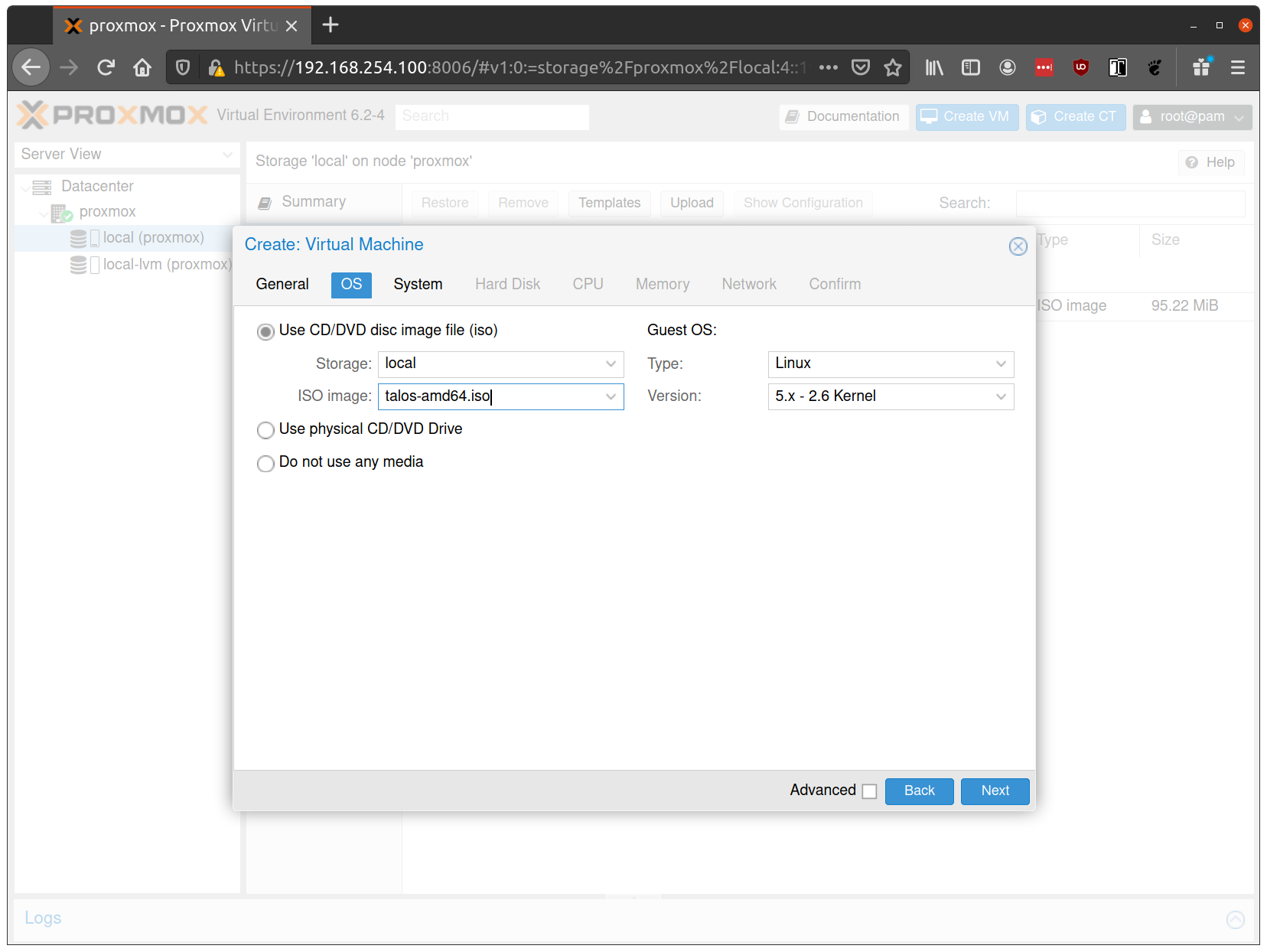
Keep the defaults set in the “System” tab.
Keep the defaults in the “Hard Disk” tab as well, only changing the size if desired.
In the “CPU” section, give at least 2 cores to the VM:
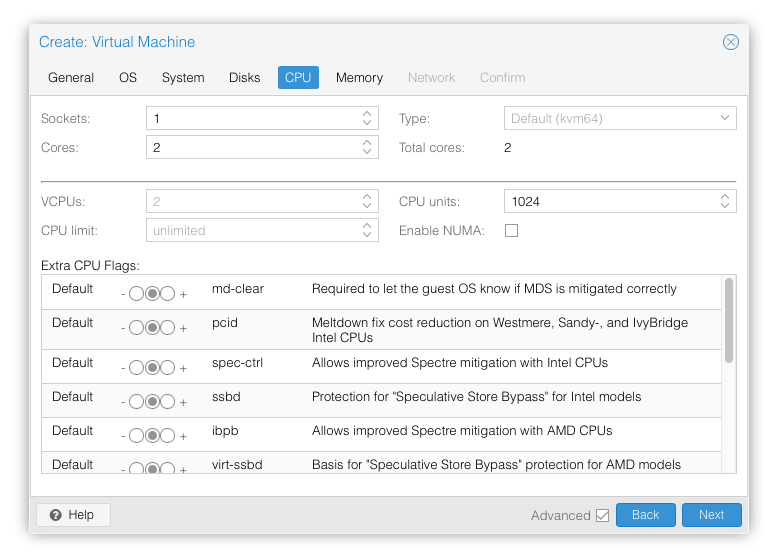
Verify that the RAM is set to at least 2GB:
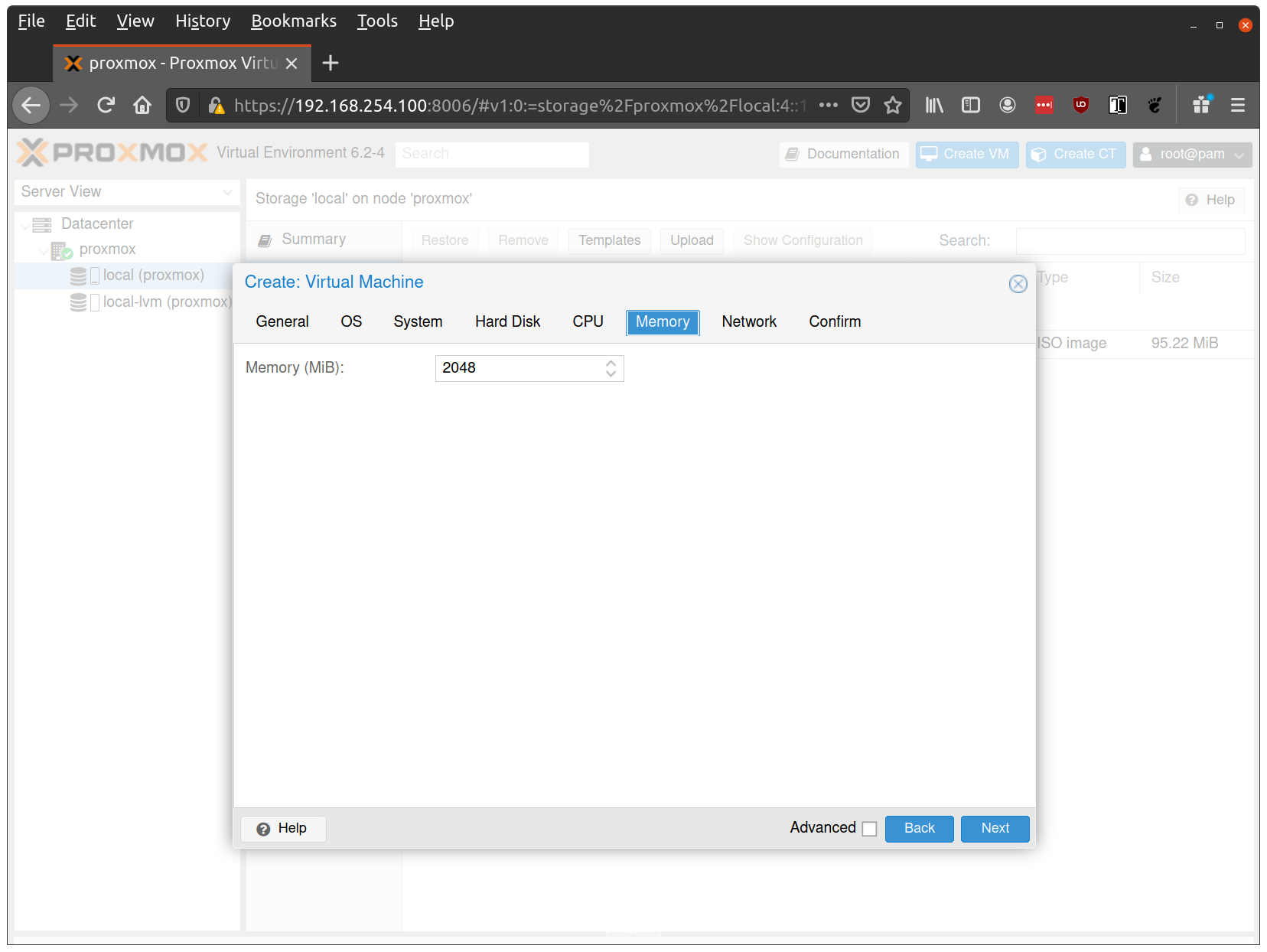
Keep the default values for networking, verifying that the VM is set to come up on the bridge interface:
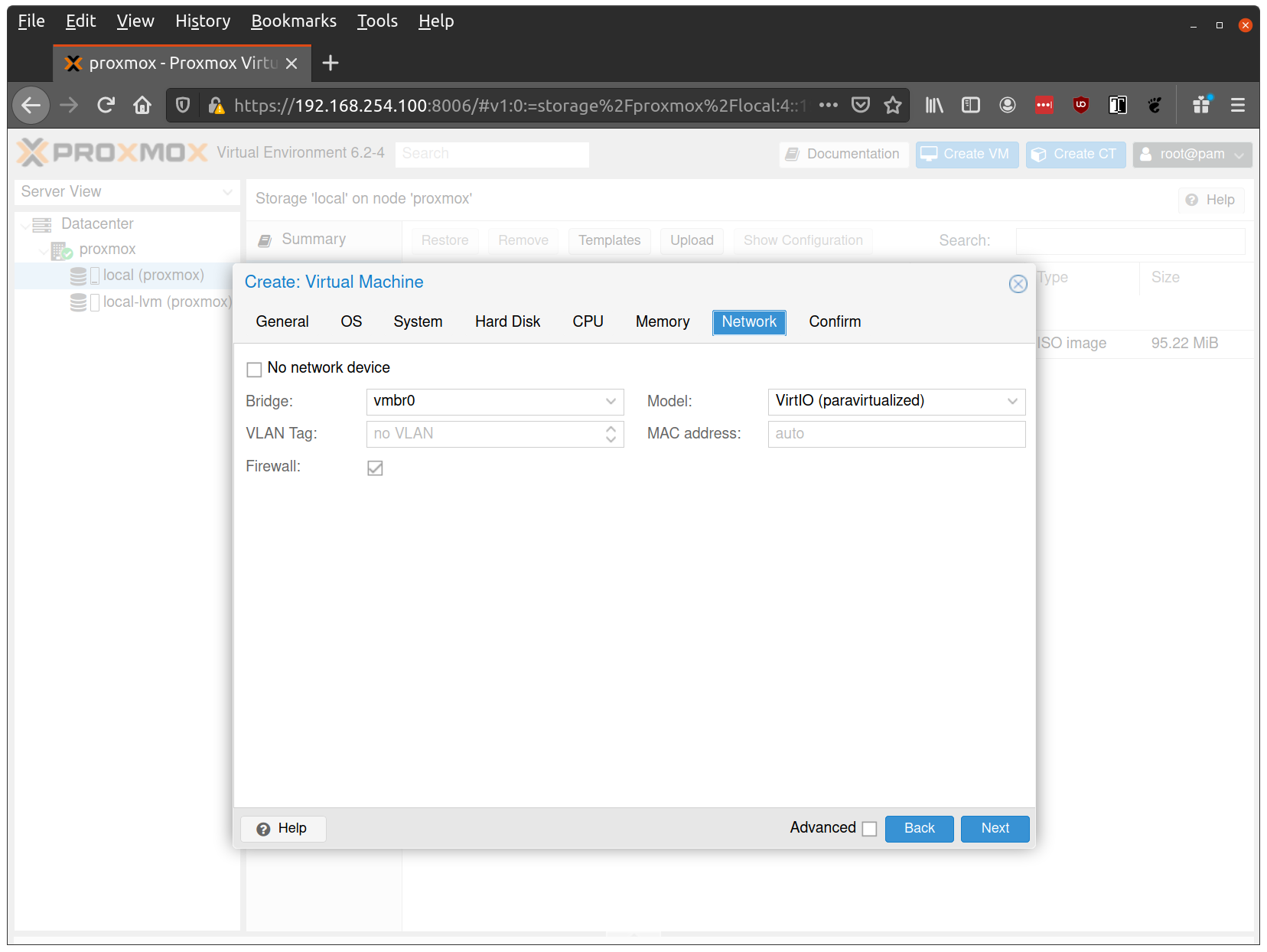
Finish creating the VM by clicking through the “Confirm” tab and then “Finish”.
Repeat this process for a second VM to use as a worker node. You can also repeat this for additional nodes desired.
Start Control Plane Node
Once the VMs have been created and updated, start the VM that will be the first control plane node.
This VM will boot the ISO image specified earlier and enter “maintenance mode”.
Once the machine has entered maintenance mode, there will be a console log that details the IP address that the node received.
Take note of this IP address, which will be referred to as $CONTROL_PLANE_IP for the rest of this guide.
If you wish to export this IP as a bash variable, simply issue a command like export CONTROL_PLANE_IP=1.2.3.4.
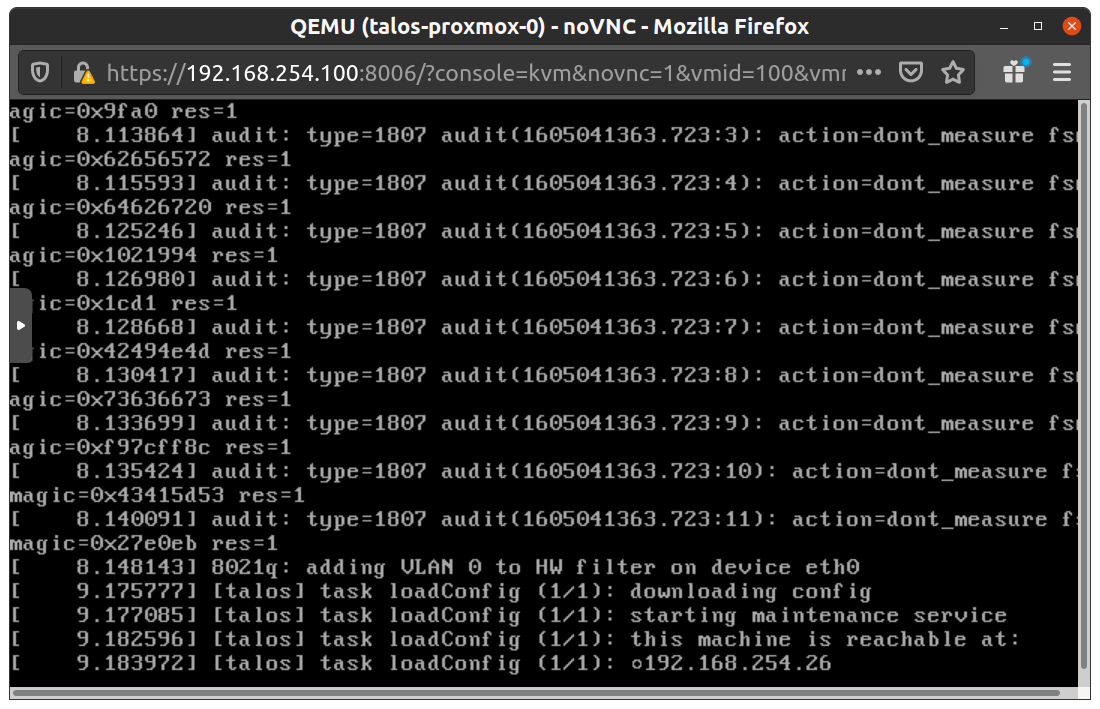
Generate Machine Configurations
With the IP address above, you can now generate the machine configurations to use for installing Talos and Kubernetes. Issue the following command, updating the output directory, cluster name, and control plane IP as you see fit:
talosctl gen config talos-vbox-cluster https://$CONTROL_PLANE_IP:6443 --output-dir _out
This will create several files in the _out directory: init.yaml, controlplane.yaml, join.yaml, and talosconfig.
Create Control Plane Node
Using the init.yaml generated above, you can now apply this config using talosctl.
Issue:
talosctl apply-config --insecure --nodes $CONTROL_PLANE_IP --file _out/init.yaml
You should now see some action in the Proxmox console for this VM. Talos will be installed to disk, the VM will reboot, and then Talos will configure the Kubernetes control plane on this VM.
Note: This process can be repeated multiple times to create an HA control plane. Simply apply
controlplane.yamlinstead ofinit.yamlfor subsequent nodes.
Create Worker Node
Create at least a single worker node using a process similar to the control plane creation above.
Start the worker node VM and wait for it to enter “maintenance mode”.
Take note of the worker node’s IP address, which will be referred to as $WORKER_IP
Issue:
talosctl apply-config --insecure --nodes $WORKER_IP --file _out/join.yaml
Note: This process can be repeated multiple times to add additional workers.
Using the Cluster
Once the cluster is available, you can make use of talosctl and kubectl to interact with the cluster.
For example, to view current running containers, run talosctl containers for a list of containers in the system namespace, or talosctl containers -k for the k8s.io namespace.
To view the logs of a container, use talosctl logs <container> or talosctl logs -k <container>.
First, configure talosctl to talk to your control plane node by issuing the following, updating paths and IPs as necessary:
export TALOSCONFIG="_out/talosconfig"
talosctl config endpoint $CONTROL_PLANE_IP
talosctl config node $CONTROL_PLANE_IP
Retrieve and Configure the kubeconfig
Fetch the kubeconfig file from the control plane node by issuing:
talosctl kubeconfig
You can then use kubectl in this fashion:
kubectl get nodes
Cleaning Up
To cleanup, simply stop and delete the virtual machines from the Proxmox UI.
4 - VMware
Creating a Cluster via the govc CLI
In this guide we will create an HA Kubernetes cluster with 3 worker nodes.
We will use the govc cli which can be downloaded here.
Prerequisites
Prior to starting, it is important to have the following infrastructure in place and available:
- DHCP server
- Load Balancer or DNS address for cluster endpoint
- If using a load balancer, the most common setup is to balance
tcp/443across the control plane nodestcp/6443 - If using a DNS address, the A record should return back the addresses of the control plane nodes
- If using a load balancer, the most common setup is to balance
Create the Machine Configuration Files
Generating Base Configurations
Using the DNS name or name of the loadbalancer used in the prereq steps, generate the base configuration files for the Talos machines:
$ talosctl gen config talos-k8s-vmware-tutorial https://<load balancer IP or DNS>:<port>
created init.yaml
created controlplane.yaml
created join.yaml
created talosconfig
$ talosctl gen config talos-k8s-vmware-tutorial https://<DNS name>:6443
created init.yaml
created controlplane.yaml
created join.yaml
created talosconfig
At this point, you can modify the generated configs to your liking.
Validate the Configuration Files
$ talosctl validate --config init.yaml --mode cloud
init.yaml is valid for cloud mode
$ talosctl validate --config controlplane.yaml --mode cloud
controlplane.yaml is valid for cloud mode
$ talosctl validate --config join.yaml --mode cloud
join.yaml is valid for cloud mode
Set Environment Variables
govc makes use of the following environment variables
export GOVC_URL=<vCenter url>
export GOVC_USERNAME=<vCenter username>
export GOVC_PASSWORD=<vCenter password>
Note: If your vCenter installation makes use of self signed certificates, you’ll want to export
GOVC_INSECURE=true.
There are some additional variables that you may need to set:
export GOVC_DATACENTER=<vCenter datacenter>
export GOVC_RESOURCE_POOL=<vCenter resource pool>
export GOVC_DATASTORE=<vCenter datastore>
export GOVC_NETWORK=<vCenter network>
Download the OVA
A talos.ova asset is published with each release.
We will refer to the version of the release as $TALOS_VERSION below.
It can be easily exported with export TALOS_VERSION="v0.3.0-alpha.10" or similar.
curl -LO https://github.com/siderolabs/talos/releases/download/$TALOS_VERSION/talos.ova
Import the OVA into vCenter
We’ll need to repeat this step for each Talos node we want to create. In a typical HA setup, we’ll have 3 control plane nodes and N workers. In the following example, we’ll setup a HA control plane with two worker nodes.
govc import.ova -name talos-$TALOS_VERSION /path/to/downloaded/talos.ova
Create the Bootstrap Node
We’ll clone the OVA to create the bootstrap node (our first control plane node).
govc vm.clone -on=false -vm talos-$TALOS_VERSION control-plane-1
Talos makes use of the guestinfo facility of VMware to provide the machine/cluster configuration.
This can be set using the govc vm.change command.
To facilitate persistent storage using the vSphere cloud provider integration with Kubernetes, disk.enableUUID=1 is used.
govc vm.change \
-e "guestinfo.talos.config=$(cat init.yaml | base64)" \
-e "disk.enableUUID=1" \
-vm /ha-datacenter/vm/control-plane-1
Update Hardware Resources for the Bootstrap Node
-cis used to configure the number of cpus-mis used to configure the amount of memory (in MB)
govc vm.change \
-c 2 \
-m 4096 \
-vm /ha-datacenter/vm/control-plane-1
The following can be used to adjust the ephemeral disk size.
govc vm.disk.change -vm control-plane-1 -disk.name disk-1000-0 -size 10G
govc vm.power -on control-plane-1
Create the Remaining Control Plane Nodes
govc vm.clone -on=false -vm talos-$TALOS_VERSION control-plane-2
govc vm.change \
-e "guestinfo.talos.config=$(base64 controlplane.yaml)" \
-e "disk.enableUUID=1" \
-vm /ha-datacenter/vm/control-plane-2
govc vm.clone -on=false -vm talos-$TALOS_VERSION control-plane-3
govc vm.change \
-e "guestinfo.talos.config=$(base64 controlplane.yaml)" \
-e "disk.enableUUID=1" \
-vm /ha-datacenter/vm/control-plane-3
govc vm.change \
-c 2 \
-m 4096 \
-vm /ha-datacenter/vm/control-plane-2
govc vm.change \
-c 2 \
-m 4096 \
-vm /ha-datacenter/vm/control-plane-3
govc vm.disk.change -vm control-plane-2 -disk.name disk-1000-0 -size 10G
govc vm.disk.change -vm control-plane-3 -disk.name disk-1000-0 -size 10G
govc vm.power -on control-plane-2
govc vm.power -on control-plane-3
Update Settings for the Worker Nodes
govc vm.clone -on=false -vm talos-$TALOS_VERSION worker-1
govc vm.change \
-e "guestinfo.talos.config=$(base64 join.yaml)" \
-e "disk.enableUUID=1" \
-vm /ha-datacenter/vm/worker-1
govc vm.clone -on=false -vm talos-$TALOS_VERSION worker-2
govc vm.change \
-e "guestinfo.talos.config=$(base64 join.yaml)" \
-e "disk.enableUUID=1" \
-vm /ha-datacenter/vm/worker-2
govc vm.change \
-c 4 \
-m 8192 \
-vm /ha-datacenter/vm/worker-1
govc vm.change \
-c 4 \
-m 8192 \
-vm /ha-datacenter/vm/worker-2
govc vm.disk.change -vm worker-1 -disk.name disk-1000-0 -size 50G
govc vm.disk.change -vm worker-2 -disk.name disk-1000-0 -size 50G
govc vm.power -on worker-1
govc vm.power -on worker-2
Retrieve the kubeconfig
At this point we can retrieve the admin kubeconfig by running:
talosctl --talosconfig talosconfig config endpoint <control plane 1 IP>
talosctl --talosconfig talosconfig config node <control plane 1 IP>
talosctl --talosconfig talosconfig kubeconfig .
5 - Xen
Talos is known to work on Xen; however, it is currently undocumented.